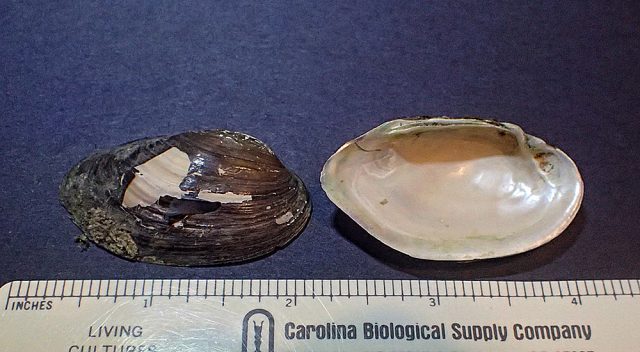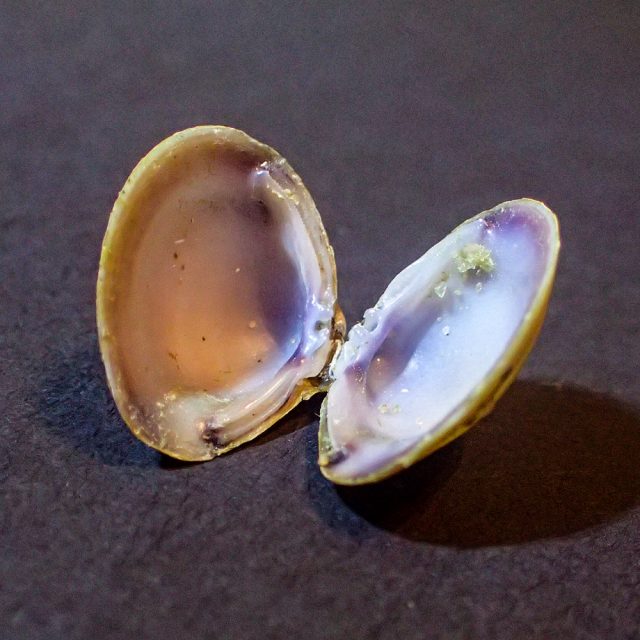06/23/2017 – The Little-Known World of Freshwater Mussels (Karen Benson)

This freshwater mussel shell was collected from a south Texas creek. The pearlescent interiors of this and larger species are quite pretty. Disks cut from the shells made attractive shell buttons. Mussels were widely exploited for the button-making industry until the mid-1950s. Robert Benson photo.
The Little-Known World of Freshwater Mussels
They have names like Pigtoes, Pistolgrips, Fatmuckets, Washboards, Pimplebacks, and Heelsplitters. What kind of animals are these? Well, they are freshwater mussels and their names refer to shapes and sizes of their shells. It does not take too much imagination to figure out how the Heelsplitter got its name, does it?
Over 50 species of freshwater mussels are found in Texas’ rivers, streams, ponds and lakes. There may be, or have been, more. In 1992, Texas Parks and Wildlife (TPWD) initiated a study of freshwater mussels in the state. By then mussel populations were seriously depleted and several species were presumed extinct. How did this happen?
Native Americans harvested the mollusks for food, tools, and jewelry, but with “little apparent impact on mussel populations.” However, settlers to the continent were prone to occasional “pearl rushes” not unlike the Gold Rush, in which pearl-hunters raced out to search for gem-quality pearls. Pearl rushes led to overharvest of mussels in some areas in the 1800s. Then, just before the turn of the centruy, mussel shells became the standard material for buttons. The button-making industry contributed to widespread harvest of the larger mussels, particularly those with lovely, pearlescent shell interiors. Pearl button-making continued until the mid-1900s at which time the development of plastics eased the industry’s demand for mussel shells.

Asian Clams are an introduced species that has become widely invasive in North American waterways. They out-compete and out-reproduce the native freshwater mussels. Robert Benson photo.
Meanwhile, “pollution, dam-building activity, and other human related environmental alterations impacted freshwater mussel populations as well.” Sadly, our environmental problems have not gone away. Plus, a new business has sprung up to threaten the animals: the cultured pearl industry.
To make a cultured pearl, an oyster farmer (typically in Japan and Southeast Asia) surgically implants a tiny polished bead made from an American mussel shell into a saltwater oyster. A small piece of a host oyster’s mantle surrounds the bead. The mantle is the pearl-producing organ; it secretes nacre, a chemical mix of calcium carbonate and conchiolin, to encyst the tiny bead. Over several years, the layers of nacre build up and a pearl is formed.
Wikipedia states that “the development of cultured pearls took much of the chance, risk, and guesswork out of the pearl industry, allowing it to become stable and predictable, fostering its rapid growth in the past 100 years. Today, more than 99% of all pearls sold worldwide are cultured pearls.” Nearly every one of those pearls got its start with a nucleus made from a bead of freshwater mussel shell from America.
Still, mussels could probably make a comeback except for yet another factor. An invasive species, the Asian Clam (Corbicula species), competes with native mussels for food and space in our waterways. Asian Clams were first observed in the Pacific Northwest in 1938. Speculation as to how the introduction occurred abounds. Some researchers suggest that they were imported for food, or for the pet trade, and were accidentally released. In any case, Asian Clams now inhabit all the major river systems in Texas. They have spread throughout the Mississippi drainage and to the eastern seaboard. They thrive in less than optimal waters and on almost any kind of substrate: silty, sandy, muddy and even on bedrock. Our native mussels have much more specific needs as to type of substrate and quality of water.
Having heard about the plight of our freshwater mussels, I decided to go to a local creek and see what species are making a living there. Unfortunately, I found Asian Clams. Lots of them. Their small golden-brown shells are sturdy and concentrically ringed on the outside. The inside is usually whitish purple. Empty shells littered the creek bed; raccoons, some fish, and possibly waterfowl eat the clams. When I dug an inch or two under the surface of the creek bottom, I found many live clams.
I also found a few mussel shells. They were elongated ellipses with the outside covered with a blackish brown epidermis. Using TPWD’s Freshwater Mussels of Texas (1996) by Howells, Neck, and Murray, I tried to identify them. I think they are Tapered Pondhorns (Uniomerus diclivus) but I am no expert on the identification of mussels. They could easily be Pond Mussels. Either way, I am sure they are native mussels. I was glad to find them.
You would think that something as simple as a mussel would have a pretty easy time of it. Not so with our native mussels. Not only do they need good water, suitable substrate, limited competition, they need a fish host for their parasitic young to grow on.
Freshwater mussels have a unique reproductive strategy. Most species have separate sexes. The male releases sperm directly into the water. The female takes in the sperm during respiration and feeding. The eggs are fertilized on the gills of the female and they hatch there in special brood pouch called the marsupium. A nutrient-rich mucus is secreted around the larvae and they feed on this for as long as several months. Then, the larvae, called glochidia, are released into the water. They are microscopic bivalves that look like “Pac-Man” and they use their two shells to clamp onto the gills or fins of fish. In some species, the glochidia have fangs or hooks to help them hang on. For a while, they are parasites on those fish. Some mussel species can only parasitize one species of fish. Glochidia that do not contact an appropriate host fish within a few days will die. After a period of days to months, the maturing glochidia drop off and burrow into the substrate to feed and grow into adults.
I had no idea such incredible activity was going on in the creeks and ponds near me! Did you?
